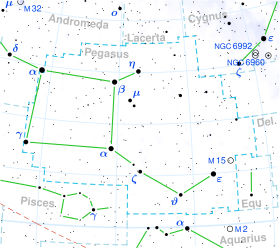Beta Pegasi
Red giant star in the constellation Pegasus From Wikipedia, the free encyclopedia
Beta Pegasi (β Pegasi, abbreviated Beta Peg, β Peg), formally named Scheat /ˈʃiːæt/,[12][13] is a red giant star and the second-brightest star (after Epsilon Pegasi) in the constellation of Pegasus. It forms the upper right corner of the Great Square of Pegasus,[14] a prominent rectangular asterism.
| Observation data Epoch J2000 Equinox J2000 | |
|---|---|
| Constellation | Pegasus |
| Right ascension | 23h 03m 46.45746s[1] |
| Declination | +28° 04′ 58.0336″[1] |
| Apparent magnitude (V) | 2.42[2] (2.31 – 2.74)[3] |
| Characteristics | |
| Spectral type | M2.5II–IIIe[4] |
| U−B color index | +1.96[2] |
| B−V color index | +1.67[2] |
| Variable type | Semi-regular[5] |
| Astrometry | |
| Radial velocity (Rv) | +8.7[6] km/s |
| Proper motion (μ) | RA: +187.65[1] mas/yr Dec.: +136.93[1] mas/yr |
| Parallax (π) | 16.64±0.15 mas[1] |
| Distance | 196 ± 2 ly (60.1 ± 0.5 pc)[1] |
| Absolute magnitude (MV) | −1.41[7] |
| Details | |
| Mass | 1.7±0.3[8] M☉ |
| Radius | 109±7[9] R☉ |
| Luminosity | 1,644[8][a] L☉ |
| Surface gravity (log g) | 1.20[10] cgs |
| Temperature | 3,606[8] K |
| Metallicity [Fe/H] | −0.11[10] dex |
| Rotational velocity (v sin i) | 9.7[11] km/s |
| Other designations | |
| Scheat, 53 Pegasi, HR 8775, BD+27°4480, HD 217906, SAO 90981, FK5 870, HIP 113881[4] | |
| Database references | |
| SIMBAD | data |
Nomenclature
β Pegasi (Latinised to Beta Pegasi) is the star's Bayer designation.
It bore the traditional name of Scheat, a name that had also been used for Delta Aquarii. The name was derived from the Arabic Al Sā'id "the upper arm", or from Sa'd.[14] In 2016, the International Astronomical Union organised a Working Group on Star Names (WGSN)[15] to catalog and standardise proper names for stars. The WGSN's first bulletin of July 2016[16] included a table of the first two batches of names approved by the WGSN; which included Scheat for this star (the name Skat was later approved for Delta Aquarii[13]).
In Chinese, 室宿 (Shì Xiù), meaning Encampment, refers to an asterism consisting β Pegasi and α Pegasi.[17] Consequently, the Chinese name for β Pegasi itself is 室宿二 (Shì Xiù èr), "the Second Star of Encampment".[18]
Distance and properties
Summarize
Perspective

Based upon parallax measurements, Beta Pegasi is located about 196 light-years (60 parsecs) from the Sun.[1] It is unusual among bright stars in having a relatively cool surface temperature compared to stars like the Sun. This star has a stellar classification of M2.3 II–III,[4] which indicates the spectrum has characteristics partway between a bright giant and a giant star. It has expanded until it is 109 times as large,[9] and has a total luminosity of 1,640 times that of the Sun.[8] The effective temperature of the star's outer envelope is about 3,600 K,[8] giving the star the characteristic orange-red hue of an M-type star.[20] The photosphere is sufficiently cool for molecules of titanium oxide to form.[21]
Johann Friedrich Julius Schmidt discovered that Beta Pegasi is a variable star, in 1847.[22] Beta Pegasi is a semi-regular variable with a period of 43.3 days[5] and a brightness that varies from magnitude +2.31 to +2.74 (averaging 2.42).[3] It is losing mass at a rate at or below 10−8 times the Sun's mass per year, which is creating an expanding shell of gas and dust with a radius of about 3,500 times the Sun's radius (16 astronomical units).[23]
Notes
References
Wikiwand - on
Seamless Wikipedia browsing. On steroids.

